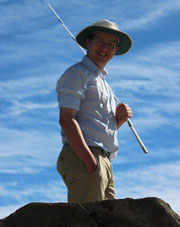Dr Jack Matthews, Museum Research Fellow

Email: jack.matthews@oum.ox.ac.uk
Phone: +44 (0)1865 272964
Research summary
My research examines the geoconservation of the fossiliferous horizons at Mistaken Point Ecological Reserve, Newfoundland. Well known for exhibiting the oldest-known large, complex organisms, Mistaken Point has recently been inscribed as a UNESCO World Heritage Site – a designation that will lead to increased tourist numbers at the site. Using innovative new techniques, I examine the effects of tourist visitors to the Ediacaran localities of Newfoundland, and develop protocols to mitigate damage to these unique geological resources. Working with Government, local communities, and businesses, my research seeks to influence management and legislative practices to secure a sustainable geotourism industry in these areas. In addition, I continue my research on the stratigraphy, sedimentology, and palaeontology of the Ediacaran rocks of Avalonia, providing a wider environmental context to the rise and fall of the biotas of the Ediacaran.
Biography
- MEarthSci Earth Sciences (University of Oxford, 2011)
- DPhil Earth Sciences “The stratigraphical contexts of the Ediacaran biota of Eastern Newfoundland” (University of Oxford, 2016)
- Postdoctoral Research Fellow (Memorial University of Newfoundland, 2016-2018)
Selected publications
Jack J Matthews, Alexander G Liu, Duncan McIlroy (In Review). Post-Fossilisation Processes: Implications for Understanding Ediacaran Palaeocommunities. Special Publication of the Geological Society of London
Alexander G Liu, Jack J Matthews, Duncan McIlroy (2015). The Beothukis/Culmofrons problem and its bearing on Ediacaran macrofossil taxonomy: evidence from an exceptional new fossil locality. Palaeontology, Early View. doi:10.1111/pala.12206
Emily G. Mitchell, Charlotte G. Kenchington, Alexander G. Liu, Jack J. Matthews, & Nicholas J. Butterfield (2015). Reconstructing the reproductive mode of an Ediacaran macro-organism. Nature, 524, 343-346. doi: 10.1038/nature14646
AG Liu, JJ Matthews, LR Menon, D McIlroy, MD Brasier (2015). The arrangement of possible muscle fibres in the Ediacaran taxon Haootia quadriformis. Proceedings of the Royal Society, B. 282 (1803)
David Wacey, Matt R. Kilburn, Martin Saunders, John B. Cliff, Charlie Kong, Alexander G. Liu, Jack J. Matthews and Martin D. Brasier (2014). Uncovering framboidal pyrite biogenicity using nano-scale CNorg mapping. Geology, 41 (1), 27-30
Liu, A.G., Matthews, J.J., Menon, L.R., McIlroy, D. & Brasier, M.D. (2014). Haootia quadriformis n. gen., n. sp., interpreted as a muscular cnidarian impression from the late Ediacaran Period (~560 Ma). Proceedings of the Royal Society, B, 281(1793)
Liu, A.G., McIlroy, D. Brasier, M.D. & Matthews, J.J. (2014). Confirming the metazoan character of a 565 Ma trace fossil assemblage from Mistaken Point, Newfoundland. Palaios, v. 29. no. 8, p. 420-430
Martin D. Brasier, Alexander G. Liu, Latha Menon, Jack J. Matthews, Duncan McIlroy, David Wacey (2013). Explaining the exceptional preservation of Ediacaran rangeomorphs from Spaniard's Bay, Newfoundland: A hydraulic model. Precambrian Research, 231, 122-135
Liu, A. G., McIlroy, D., Matthews, J. J. and Brasier, M. D. (2013). Exploring an Ediacaran ‘nursery’: growth, ecology and evolution in a rangeomorph palaeocommunity. Geology Today, 29, 23-26.
Alexander G. Liu, Duncan McIlroy, Jack J. Matthews, and Martin D. Brasier, (2012). A new assemblage of juvenile Ediacaran fronds from the Drook Formation, Newfoundland. Journal of the Geological Society, v. 169, no. 4, p. 395-403.
